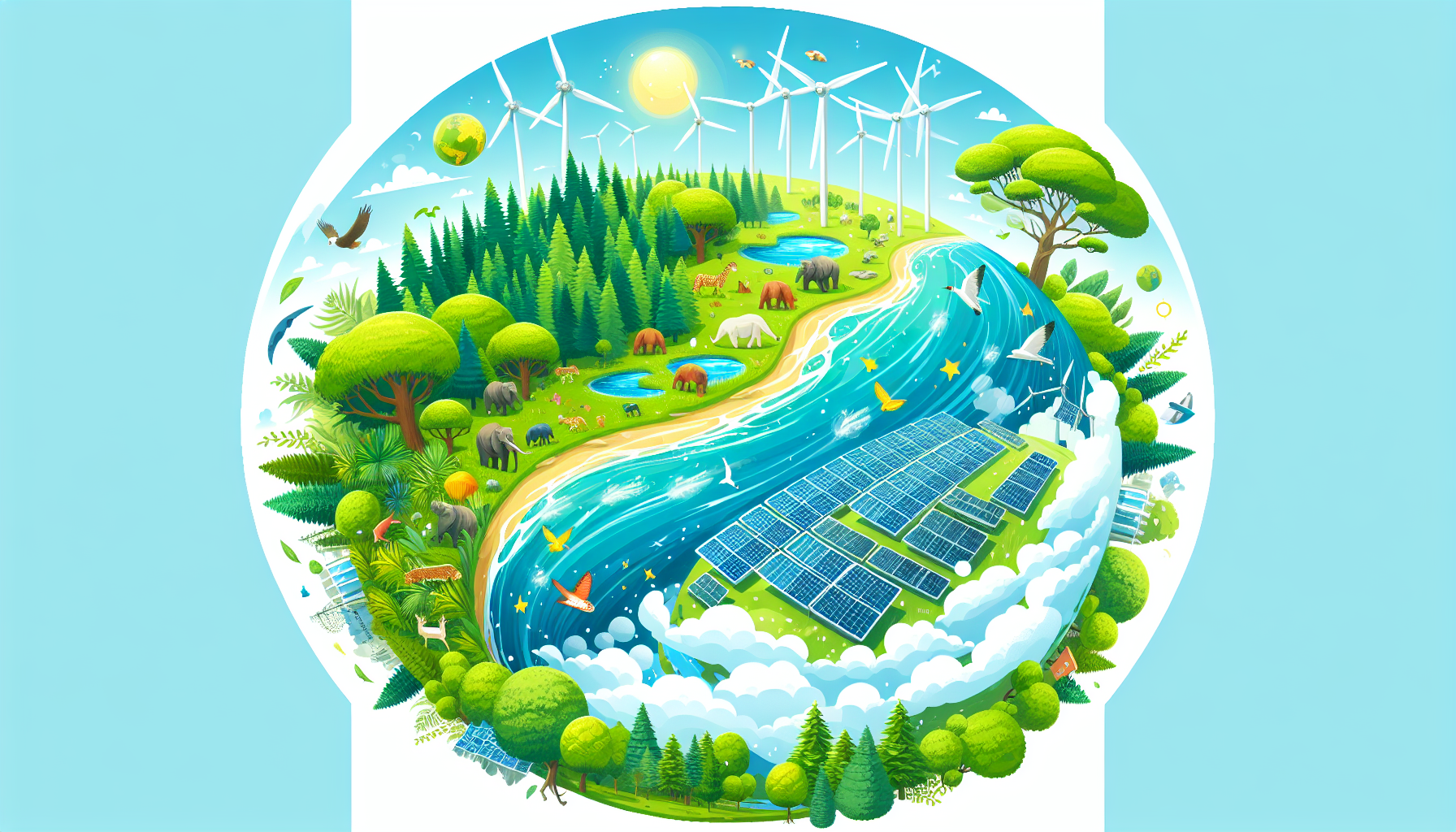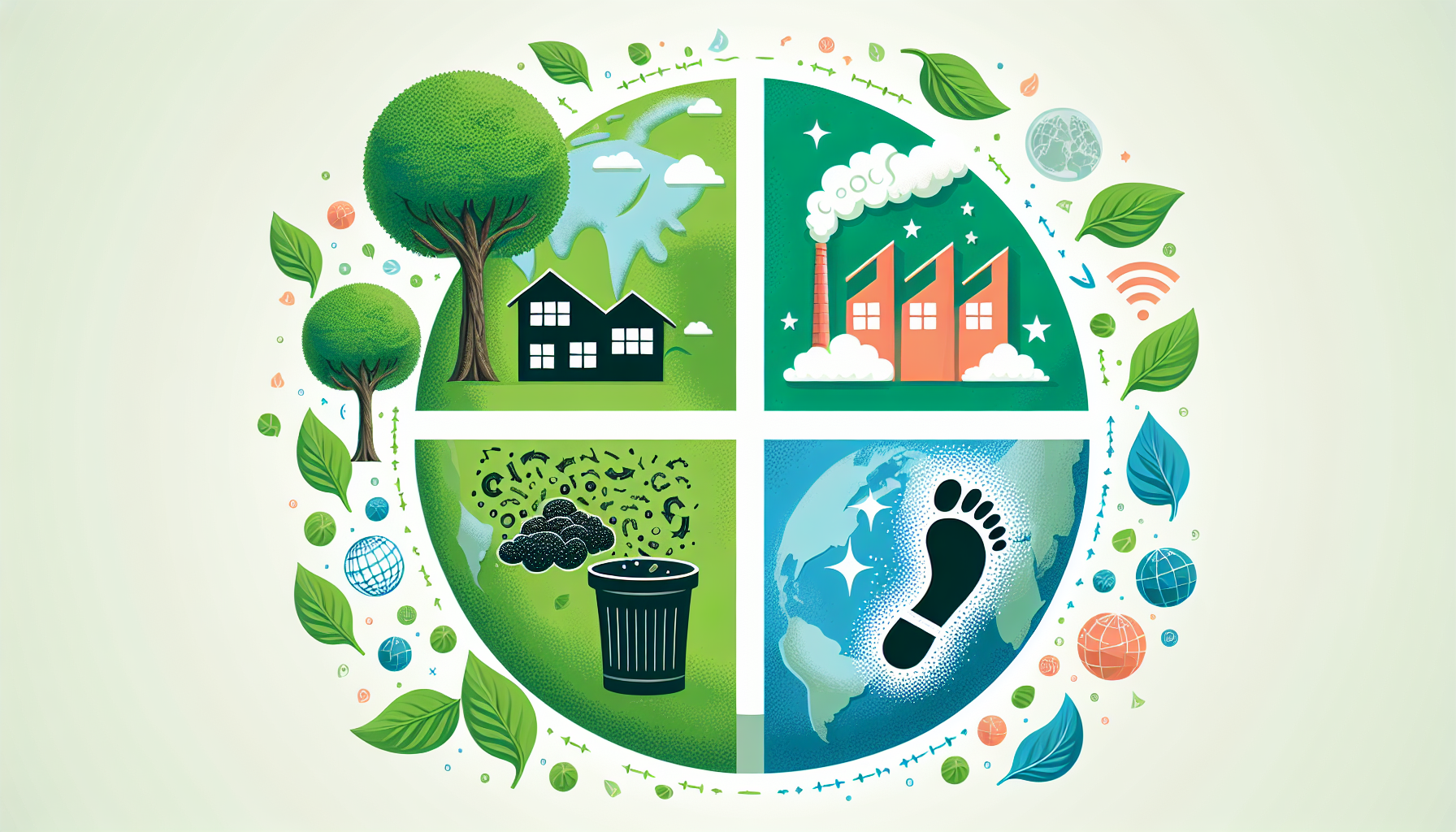Exploring Sustainability in the Environment: Strategies for a Healthier Planet
What is ‘sustainability in the environment’ and how do we effectively achieve it? This article cuts to the core of these critical questions, showcasing the essential actions for preserving our planet’s future. You’ll be guided through the pressing need to balance our use of natural resources, the intertwined roles of economic, environmental, and social sustainability, and the compelling strategies and policies shaping our sustainable tomorrow. Join us as we explore the vital journey towards a sustainable world without compromising the needs of future generations.
Key Takeaways
-
Environmental sustainability is a critical balance between current consumption and preserving resources for future generations, involving actions to reduce pollution, resource depletion, and climate change while promoting social responsibility and maintaining ecological integrity.
-
Sustainability rests on three interconnected pillars—environmental protection, economic development, and social development—with each supporting the others in a sustainable balance, requiring responsible management of natural, economic, and social resources to ensure the well-being of society and the planet.
-
Achieving environmental sustainability involves individual, corporate, and governmental efforts to manage resource use, promote renewable energies, reduce waste, and implement regulations, with forward-looking strategies that include technological advances and adaptation to climate change.
Understanding Environmental Sustainability

Environmental sustainability involves a delicate balance between our consumption of natural resources and their availability. It’s about meeting our needs today without compromising the ability of future generations to meet theirs. This balance ensures a quality of life for current and future generations that is at least as good as the one we enjoy today.
Unrestricted consumption can lead to:
-
Polluted environments
-
Depleted resources
-
Global crises in food and energy production
-
Increased greenhouse gas emissions, contributing to global warming
Hence, it is urgent that we strive for environmental sustainability, which environmental sustainability refers to through the application of environmental science.
Defining Environmental Sustainability
The concept of environmental sustainability is about using natural resources responsibly to prevent their depletion and maintain long-term environmental quality. Sustainable development is closely related to environmental sustainability. It is defined as the development that meets the needs of the present without compromising the ability of future generations to meet their needs..
The core principle of environmental sustainability lies in maintaining ecological integrity. This involves:
-
The careful and conservative use of finite resources
-
Preserving natural resources
-
Ensuring a healthy planet for future generations
-
Supporting human well-being through socially responsible practices
-
Promoting a dynamic equilibrium in human and natural systems
The Importance of Environmental Sustainability
The health of our environment is inherently linked to human health and well-being. Access to clean air, water, and a life free from toxic substances is paramount to our survival and prosperity. It’s not just about us, but also the generations to come. Environmental sustainability is essential to conserve natural resources and protect global ecosystems, thereby supporting health and well-being now and into the future.
Efforts towards mitigating climate change through sustainable practices are of utmost importance in order to prevent extreme weather events, floods, droughts, and potential social upheaval. Given its forward-looking nature, environmental sustainability advocates for resource conservation for future generations to maintain, at least, our current level of well-being.
Achieving a balance between environmental protection and human development is foundational for the prosperity of both the natural world and human society.
The Three Pillars of Sustainability

The path to a sustainable planet is underpinned by three interconnected pillars: environmental protection, economic development, and social development. These pillars are inseparable, each one supporting the others to maintain a sustainable balance required for a healthy planet and society.
The economy’s productive base comprises these three types of capital—economic, environmental, and social—which must be managed and utilized sustainably.
The environmental pillar serves as the foundation. It’s critical for the existence and effectiveness of the economic and social pillars. Next, we will examine each of these pillars in detail, exploring their importance and roles in fostering sustainability.
Environmental Pillar
Sustainable development focuses on the environmental pillar of sustainability, which aims to preserve our finite resources and ensure a better quality of life for both present and future generations. This involves reducing global issues such as world hunger, warming, and natural disasters, and safeguarding animal welfare. For instance, forests contribute immensely to environmental sustainability by capturing and storing carbon dioxide and playing a critical role in the water cycle.
Protecting the environment is not just about reducing carbon emissions or recycling. It’s about sustaining the very fabric of life on Earth, from the air we breathe to the water we drink, and the soil that provides us with food. Every small step towards environmental protection can lead to significant changes, contributing to a more sustainable future.
Social Pillar
The social pillar of sustainability includes various components, such as:
-
Equity
-
Diversity
-
Social cohesion
-
Quality of life
-
Democracy
-
Governance
It takes into account the impacts of corporations on social sustainability, considering aspects such as human rights, fair labor practices, and community engagement.
Equity in social and environmental sustainability prompts fair participation in environmental decisions, promotes community resilience to climate-related events, and addresses disparities in resources and exposure to risks. Incorporating social sustainability into business practices can be challenging but rewarding, leading to healthier, more productive workers, and includes assessing interaction with the community, focusing on employee well-being and equality policies.
Economic Pillar
The economic pillar of sustainability refers to practices that encourage long-term economic growth while managing the environmental, social, and cultural aspects of activities. This means addressing environmental and sustainability issues is crucial for creating a stronger long-term economic and social model, allowing for truly sustainable growth.
For a business, achieving economic sustainability ensures long-term growth by preventing the exhaustion of natural or human resources, thus stabilizing the business context. Businesses often integrate economic sustainability into their operations by:
-
Assessing energy use
-
Reducing waste
-
Improving social practices
-
Bolstering customer loyalty
Honest accounting, transparency, and regulatory compliance are key components of economic sustainability for businesses and government policies. While profitability is necessary for a business to be sustainable, it must be balanced with the environmental and social pillars of sustainability.
Strategies for Achieving Environmental Sustainability

Attaining environmental sustainability requires:
-
Managing the harvesting of renewable resources so they don’t surpass their natural regeneration rates
-
Developing alternatives to non-renewable resources to avoid their depletion
-
Regulating waste production within the environment’s absorption capacity
This involves a collective effort from all stakeholders, including individuals, corporations, and governments.
The adoption of sustainable materials and demand for plant-based diets, increasing renewable energy usage, and reduction of food waste are trends that contribute to mitigating climate change through reduced greenhouse gas emissions. We will further explore these strategies, beginning with actions that individuals can take.
Individual Actions
As individuals, our lifestyle choices can have a significant impact on environmental sustainability. Here are some key actions individuals can take to reduce their carbon footprint:
-
Carpooling
-
Using public transportation
-
Walking
-
Cycling
-
Remote work practices
Transportation choices like these can help promote a more sustainable future.
Consumers play a role in sustainability by purchasing locally-produced goods and embracing a rising demand for plant-based and alternative foods, which have smaller environmental footprints compared to traditional agricultural products. Households can significantly decrease energy consumption and their overall environmental impact by integrating smart thermostats, energy-efficient appliances, electric vehicles, and technologies facilitating remote work.
Corporate Responsibility
Corporations have a crucial part in advancing environmental sustainability. Some ways in which they can do this include:
-
Adopting renewable energy sources, which not only reduce carbon emissions but also present new job opportunities
-
Reducing operational energy use, which can lead to cost savings and increased efficiency
-
Reducing plastic in production, which not only helps the environment but can also increase profit margins
By aligning business profitability with environmental sustainability, corporations can contribute to a more sustainable future.
Businesses are experiencing growing pressure to prioritize environmental responsibilities and provide greater transparency regarding their sustainability measures. Sustainable supply chain management requires attention to the environmental and human impacts of the supply chain from raw material sourcing to product delivery. Implementing sustainability practices leads businesses to:
-
Lower energy costs
-
Enhanced customer loyalty
-
Alignment with UN environmental sustainability standards
-
Driving a stronger business model.
Government Policies and Regulations
Government policies and regulations are instrumental in promoting environmental sustainability. Research indicates that to achieve environmental sustainability, a stronger global regulatory framework or increased commitment from businesses is required, emphasizing the importance of government leadership in these efforts.
Government environmental policies and regulations aim to reduce operation impacts through carbon emissions targets, sustainable resource use, and mandatory standards in public procurements. Local government innovations such as San Francisco’s energy-efficient public transit and water conservation efforts, alongside policies focused on robust, no-regret investments considering climate uncertainty, demonstrate proactive approaches to sustainability.
Measuring Progress Towards Environmental Sustainability

Gauging progress towards environmental sustainability involves evaluating a mix of environmental, social, and economic factors. It’s not just about counting the number of trees planted or the volume of waste recycled. It’s about assessing the overall impact of our actions in minimizing negative environmental externalities such as resource and energy consumption, waste generation, and pollution.
However, measuring sustainability is easier said than done. It presents a unique set of challenges, particularly in assigning monetary value to environmental and social capital and balancing technical accuracy with understandability. Despite these challenges, the measurement of sustainability provides crucial insights into our progress and helps us make informed decisions for a sustainable future.
Key Indicators and Metrics
The assessment of environmental sustainability entails a set of important indicators and metrics. These indicators measure the impact of actions on minimizing negative environmental externalities such as resource and energy consumption, waste generation, and pollution. Examples of these indicators include the amount of water used, product life cycle, raw materials used, carbon footprint, and carbon dioxide emissions during transit.
A corporate sustainability plan utilizes these indicators to outline strategies and objectives that are aligned with the main axes of environmental, social, and governance impact, with the indicators serving as tools to measure the achievement of these objectives.
Corporate sustainability reporting is a process where companies:
-
Publish their sustainability goals and progress
-
Provide transparency on their contribution to sustainable development
-
Demonstrate their commitment to sustainability.
Challenges in Measuring Sustainability
Though crucial, measuring sustainability comes with its own unique set of challenges. Some of these challenges include:
-
Assigning a monetary value to environmental and social capital, which is very challenging and presents significant issues for sustainability measurement.
-
The process of estimating shadow prices to represent the societal value of scarce assets is complex.
-
Existing methodologies for measuring sustainability are not refined.
There is a tension in sustainability metrics between striving for technical accuracy and creating indices that are easily understandable to a broad audience. To effectively monitor environmental sustainability, there is a need to utilize a blend of monetary and limited physical indicators, particularly when dealing with irreversible environmental changes.
Case Studies: Success Stories in Environmental Sustainability

Having explored the fundamentals, importance, and methods of environmental sustainability, let’s now shift our focus to some real-world case studies. These examples illustrate how cities and businesses around the globe are successfully implementing sustainable practices, demonstrating that environmental sustainability is not only possible but also profitable.
From Copenhagen’s super cycle highways to Singapore’s Sustainable Development Blueprint, cities are stepping up their sustainability game. On the business front, companies like UPS and IKEA are adopting sustainable practices that reduce their environmental impact and improve their profitability. Let’s further explore these success stories.
Sustainable Cities
Cities around the world are becoming more sustainable, implementing practices that reduce their environmental impact and improve the quality of life for their residents. Copenhagen’s CPH 2025 Climate Plan, for example, includes super cycle highways to encourage bike commuting and reduce car dependence. Similarly, Madrid and Paris are imposing limits on diesel vehicles and promoting the use of more fuel-efficient car models.
Stockholm, on the other hand, plans to be fossil-fuel free by 2050 and uses district heating for a significant portion of its residential heating and hot water needs. Singapore’s Sustainable Development Blueprint aims for 80 percent of buildings to be certified green and promotes extensive public transportation to lessen the need for private car ownership. These cities demonstrate that a sustainable future is not only achievable but also beneficial for all.
Innovative Businesses
Businesses have a significant role to play in promoting environmental sustainability, and many are stepping up to the challenge. For instance, UPS’s ORION AI system optimizes delivery routes, resulting in savings of 10 million gallons of fuel annually and reducing carbon emissions by 100,000 metric tonnes.
IKEA’s IWAY code of conduct ensures their suppliers adhere to environmental and humanitarian standards, including the responsible management of water and waste. Similarly, H&M’s ‘Let’s Close the Gap’ initiative promotes recycling of clothing with customer incentives, aiming for the use of 100% sustainable raw materials by 2030. These examples show that businesses can make a positive impact on the environment while also boosting their bottom line.
The Future of Environmental Sustainability
Going forward, the future of environmental sustainability is expected to be a mix of sustained efforts and new strategies. Renewable energy sources, such as solar and wind power, are expected to dominate the market due to improvements in cost-efficiency and effectiveness. Increased adoption of sustainable transportation options, including bicycles, low-carbon public transport, and electric vehicles, aligns with future environmental sustainability goals.
The use of sustainable materials like bamboo, hemp, and organic cotton is set to increase, thereby reducing the environmental footprint of various industries. Consumer practices are expected to evolve, with more individuals engaging in activities like purchasing second-hand items and composting to combat food waste. Let’s further explore the future prospects of environmental sustainability.
Climate Change and its Implications
Climate change is one of the most pressing challenges of our time, and its implications for environmental sustainability are significant. The release of carbon stored in permafrost and near-shore seabeds has the potential to significantly exacerbate climate change. Moreover, climate change induced damage to infrastructure, exemplified by melting permafrost in Yakutsk, Russia, demonstrates the critical need for effective adaptation strategies.
Exponential population growth has intensified farming activities, contributing to increased greenhouse gas emissions and widespread deforestation. Therefore, nations must choose appropriate pathways for low-carbon growth, which may include:
-
Better forest management
-
Investment in renewable energy
-
Public transport improvements
-
Disaster risk management
Technological Advancements
Technological advancements are shaping the future of environmental sustainability. Demand for more sustainable and environmentally friendly options is expected to drive the emergence of new materials and production methods, including alternatives for food production. A sustainability transition will require not only technological advancements but also far-reaching changes in lifestyles.
Emerging technologies may pose unique environmental sustainability challenges, including those associated with advanced materials, synthetic biology, digital technologies, carbon dioxide removal and sequestration, and space technologies. Therefore, there are specific recommendations for lawmakers, regulators, technology developers, research funders, technology investors, industries, and standard-setting organizations to mitigate risks to environmental sustainability.
Summary
As we’ve seen, environmental sustainability is a multifaceted concept encompassing the responsible use of natural resources, protection of ecosystems, and the promotion of a quality of life that can be sustained for generations to come. Achieving this goal requires a collective effort from individuals, corporations, and governments, guided by the three pillars of sustainability: environment, social, and economy.
While challenges exist, particularly in the measurement of sustainability and the balance of economic growth with environmental protection, the future looks promising. With the continued adoption of sustainable practices, technological advancements, and a global commitment to combat climate change, we can look forward to a more sustainable future. The journey towards environmental sustainability is as much about the destination as it is about the journey itself. It’s about creating a world where we can all thrive without compromising the ability of future generations to do the same.
Frequently Asked Questions
What is meant by environmental sustainability?
Environmental sustainability refers to the responsible use of natural resources to maintain an ecological balance and support the wellbeing of current and future generations. It involves ensuring the availability of resources for the future by interacting with the planet responsibly and avoiding depletion of natural resources.
What does sustainability do to the environment?
Sustainability aims to improve the quality of human life without putting unnecessary strain on the earth's supporting ecosystems. By making life choices that ensure an equal or better way of life for future generations, sustainability benefits the environment.
Which is an example of the environmental sustainability?
An example of environmental sustainability is the use of renewable energy sources such as solar, wind, hydroelectric, and biomass (no date).
What are the three pillars of sustainability?
The three pillars of sustainability are environmental protection, economic development, and social development, which form the basis for achieving a balanced and sustainable future.
How can individuals contribute to sustainability?
By making choices like carpooling, using public transportation, walking, cycling, purchasing locally-produced goods, and embracing a plant-based diet, individuals can significantly contribute to sustainability. These actions reduce carbon footprint and support sustainable practices.








